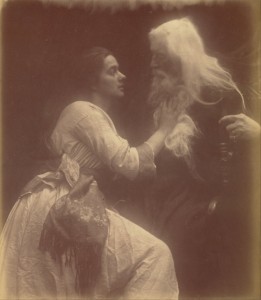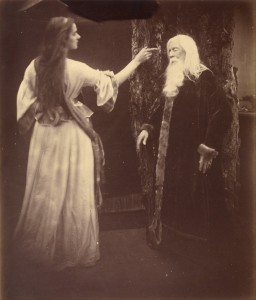
Women with magic or connections to nature are often presented as the adversary of Medieval, Romantic, and Victorian men. One of the most formidable to span across multiple periods is Nimue, Lady of the Lake. In a trio of adversaries[1] against Merlin, Nimue (the original of the three) is the one who casts a spell over the ancient wizard after stealing his power, sealing him inside a tree to sleep for all eternity. In Adolphe Lalauze’s print of Edward Burne-Jones’ The Beguiling of Merlin (1872-1877) the wizard is depicted in a reclining form, gazing up at Nimue, who is holding one of his spell books. His black cloak created a shadow which envelops his form, giving his body a rather shapeless appearance, as if he is fading out of existence. Nimue on the other hand is clothed in a garment which is incredibly similar in tone and style to the forest around her (emphasizing her inherent connection to nature). Merlin’s left hand also gestures to the narcissus flowers growing by the lakeside, alluding to Narcissus, Merlin’s own vanity and desire, and that he will eventually be turned into a plant, trapped where he lies for all time.
There are a few variations of Nimue’s tale, sometimes replacing her with Viviene (usually due to some influence from Morgana le Fay), but each story ends with Merlin having his power stolen and being put to sleep inside a tree. There is another femme fatale of this time period who also holds standing in the Pre-Raphaelite circle: La Belle Dame sans Merci. Inspired by a John Keats poem of the same title, the story of La Belle Dame revolves around a gallant knight who is beguiled by a beautiful woman (who is either fairy-like or an actual fairy or “fey”) and lulled to sleep.
“And there she lulled me asleep,
And there I dreamed – Ah! woe betide!-
The latest dream I ever dreamt
On the cold hill side.” (Keats 29-32)
Both of these women are portrayed as powerful and magical beings who ensnare brave or wise men with their beauty, letting the men fall prey to their desires and enter into a cursed sleep. Women who are entwined with nature, not bound by society (who are perhaps older than mankind), become a threat towards power structures (chivalry, Arthur’s kingdom, etc). However, because of their magical and otherworldly nature they are beyond the reach of the mortal hand of justice. Thus they serve as a warning towards men both young and old to not let their guard down because of desire. However, because they become object through art, it is okay too look, just don’t touch.
Below are two other artistic representations of this scene, photographed in 1874 by Julia Margaret Cameron and her interpretation of Vivien and Merlin.
Another medium through which the enchantment of the Arthurian femme fatale is conveyed is Nimue’s song to Merlin from the Lerner and Loewe musical Camelot.
[youtube_sc url=”https://www.youtube.com/watch?v=Tt7FGuvTTKA” title=”%22Follow%20Me%22%20Nimue%27s%20Song%20to%20Merlin%20″]
[1] In Arthurian legend Nimue is Merlin’s oldest adversary, a nymph who puts him under an eternal sleep. She is later replaced by Morgana le Fay and Vivien in various tales, her sole purpose being to give Arthur the sword Excalibur and eventually carry him to Avalon upon his death. Morgana le Fay is the half-sister of King Arthur who swears to destroy everything Merlin has built for disguising Uther Pendragon like her father so he could sleep with her mother (Lady Igraine). She later casts a spell on Arthur and sleeps with in order to produce a bastard child Mordred (sometimes it is her sister Morgause who does this), who will eventually kill Arthur. Vivien is usually portrayed as being a student of Morgana who then pretends to be a student of Merlin in order to gain his power and put him under and enchanted sleep, all a part of Morgana’s plan to destroy Arthur’s kingdom.


In addition to Nimueh representing dangerous female sexuality, in the 2008 BBC show Merlin, she also stands for the pre-Christian ideas of religion and magic. She appears as a High Priestess of the Old Religion, a very powerful magic user and a serious danger to anti-magical Camelot. She is definitely portrayed as a femme fatale, wearing bright red lipstick and clinging clothing. Since Arthur is supposed to represent anti-magical, Christian – and thus patriarchal – values, his enemies Nimueh, Morgan and Morgause represent the magical, pagan – and much more matriarchal – other that he must defeat before Christianity can rule.